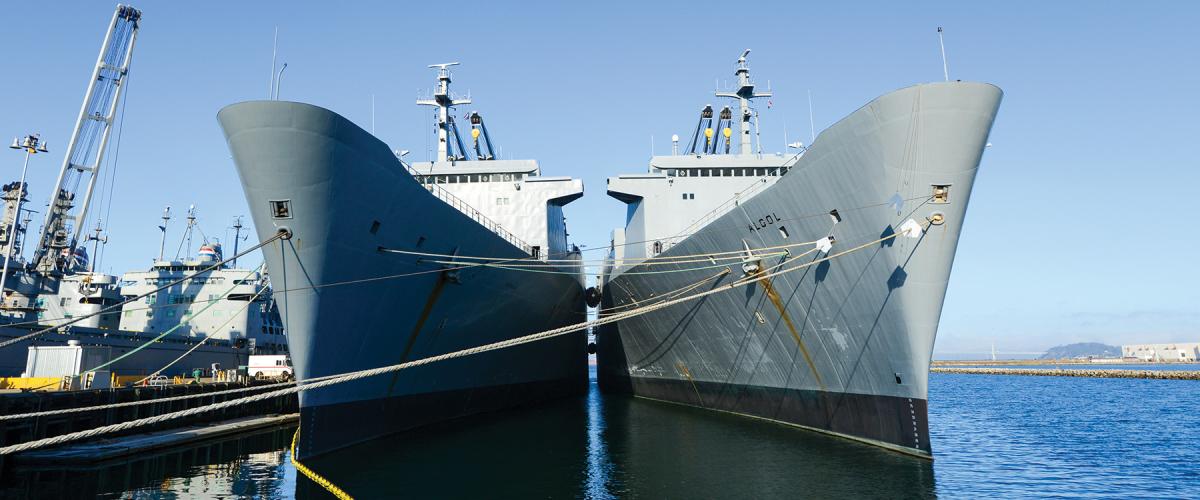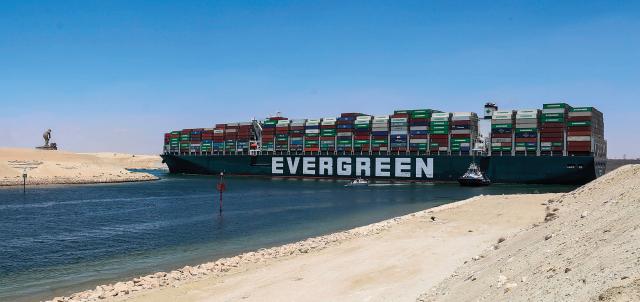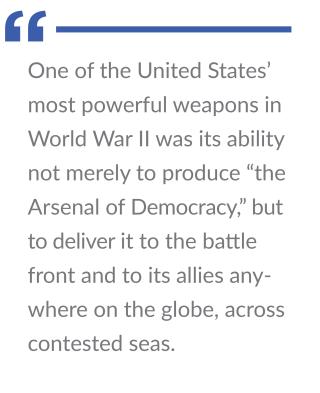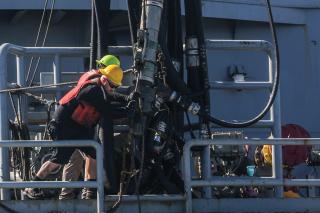In the run up to the scenario’s 2026 Chinese invasion of Taiwan, issues surrounding the U.S. Navy were well known. Numerous politicians, professionals, and experts criticized programs and shortfalls in the service. The inadequacy of the littoral combat ship, the decommissioning of Ticonderoga-class cruisers and loss of their vertical launch systems, and the delays in numerous ship construction programs all contributed to opening the famous “Davidson window.”1
Amid this clamor, a smaller group highlighted an even more significant shortfall that had the potential to cripple the U.S. military—logistics, in particular, sealift. Unfortunately, while many highlighted the issues, few remedies were adopted before China launched its offensive in the western Pacific.
Fewer Ships, Greater Threat
One of the United States’ most powerful weapons in World War II was its ability not merely to produce “the Arsenal of Democracy,” but to deliver it to the battle front and to its allies anywhere on the globe, across contested seas. The U.S. Merchant Marine lost one in every ten ships and one in 26 personnel during that conflict, but by war’s end, it was the largest commercial fleet in the world, alongside the most powerful Navy. However, as the decades passed, while the U.S. Navy remained dominant, the U.S. Merchant Marine fell.
By 2026, China possessed the second largest Navy and commercial fleet in the world. The United States, while still possessing the number one Navy (in tonnage though not in hull numbers), had a merchant marine that ranked 21st.2
In Korea, Vietnam, Kuwait, Afghanistan, and Iraq, the United States had the benefit of military bases and host-nation support close at hand. Logistics at sea were taken for granted, as material and supplies arrived just a few hundred miles from the war zones with no threats. In 1990 and again in 2003, the Afloat Prepositioning Force—created in 1985 to support the Rapid Deployment Joint Task Force, which evolved into Central Command—provided some of the first heavy sealift for land and air combat forces in theater. The Marine Corps initially had three brigades afloat. The Army placed an armored brigade and the combat support and combat service support for an entire brigade, along with a port opening package, on board ships. The Air Force loaded four ships with all the bombs, ammunition, and engineering support material to sustain combat operations for weeks.
By 2026, the Marine Corps had reduced its afloat prepositioning presence to just one brigade, split between Diego Garcia and the western Pacific. The ships in the latter sailed and operated around Korea, Japan, and the Marianas. The Army and Air Force had similarly cut back but retained portions of their earlier fleets, also equally divided. When China struck, these ships became prime targets.
The MV Maj. Bernard F. Fisher (T-AK-4396) was reaching the end of a long period of service with the Navy’s Military Sealift Command. First chartered in 1999, she was slated to come off contract in 2027, and it was unlikely the 41-year-old ship would be renewed for another five-year charter carrying U.S. Air Force ammunition.
That morning, the ship was riding at anchor at Chinhae, Republic of Korea. Because of her cargo, she rarely went pierside or in port; ships laden with explosives were set into anchorages far from populated areas. Commander, Fleet Activities Chinhae, arranged for all the services needed for the ship, including security.
Given the rising tension between China and the United States and the lack of suitable escort vessels, it was determined the best defense for the Fisher and other ships in the Afloat Prepositioning Force was to keep them at anchor or in port. The appearance of an unscheduled provision barge heading toward the Fisher triggered a security alert. Crews were aware of what had befallen the USS Cole (DDG-67) while in port in Yemen in 2000.
As patrol boats moved to intercept the barge and the on-duty helicopter moved into position, a trio of unmanned surface vessels—basically modified jet skis—launched from a nearby cove moved slowly toward the Fisher. Once the escort was distracted, the controllers of the USVs, well away from the area and linked to the craft via mobile array, throttled up and headed for the ship. With everyone’s attention drawn to the provision barge, it was the first assistant engineer having a cigarette break on the fantail who sighted the three USVs. By the time he called the bridge, the USVs were nearly on the Fisher.
The master on the bridge alerted the helicopter and patrol craft, but it was too late. All three USVs struck the starboard side of the Fisher, two amidships and one aft. The aft USV blew off the rudder, crippling the ship’s ability to maneuver, but it proved unnecessary. The two hits amidships penetrated the hull, and their explosive charges were enough to cook off several containers of ammunition. This initiated a domino effect of ammo containers exploding.
The master, seeing the initial cargo detonations, ordered the crew to abandon ship. As the portside lifeboat reached the main deck, the Fisher erupted into a massive ball of flames.
Unrep Under Attack
The Military Sealift Command (MSC) had been crewing and operating the U.S. Navy’s fleet of underway replenishment (UnRep) ships since the USS Taluga (AO-62) was transferred to its control in 1972. By the end of the Cold War, it was operating all the Navy’s auxiliary vessels. One of every five vessels in the fleet was manned by merchant mariners employed by MSC.3
In 2026, MSC employed nearly 5,600 merchant mariners to crew the UnRep fleet, but that represented only 1.2 people per billet, or six people for every five positions. This meant reliefs often were delayed well past the authorized four months, and what leave mariners were afforded did not last long before they were called back to work. While large signing and retention bonuses were available, crewing proved an issue.4
MSC divided its UnRep fleet equally between the Atlantic and Pacific, with more than half the ships assigned to the Pacific Fleet forward deployed to Japan, Korea, Singapore, and the Philippines. The morning of the attack found two oilers and one dry cargo/ammunition ship in Subic Bay.
The USNS John Lewis (T-AO-205), lead ship of the newest class of oilers in the MSC fleet, entered service in 2022 but did not actually deploy until 2024, well behind schedule. She rode at anchor at Subic Bay, while the USNS Charles Drew (T-AKE-10) set pierside taking on stores. Across the bay, at Keppel Marine, the venerable Henry J. Kaiser–class replenishment oiler USNS Tippecanoe (T-AO-199) sat in drydock undergoing repairs.
The Philippines had once been home to MSC’s first underway replenishment oilers, supporting the end of the Vietnam War and the carriers at Yankee Station. With the end of the Cold War, damage to U.S. facilities from the Mount Pinatubo eruption, and declining relations with the Philippine government, however, the United States left the base at Subic. China’s expansion into the South China Sea—both its militarization of newly created islands and challenges to Philippine sovereignty over several areas, including Second Thomas Shoal—led to a revitalized U.S. presence in the islands.
Along the shore of Subic Bay, new fuel tanks had sprouted up. With the closure of the Red Hill Fuel Facility in Hawaii, the United States adopted a policy of distributed fuel logistics, which meant more fuel prepositioned and stationed around the area.
The launch of medium-range ballistic missiles from southern China triggered alarms globally. The fear of nuclear strikes was ever present, but these missiles were not going far. As they completed their arcs and descended back to Earth, they headed for Subic Bay. The strike on Alava Wharf flattened the Port of Subic Administration building. The Charles Drew took a direct hit through the superstructure, and the explosion blew out her sides, causing her to roll against the wharf.
As the missiles angled toward the fuel farms, they broke apart into smaller weapons, starting a chain of explosions and incinerating millions of barrels of diesel and jet fuel. The Tippecanoe in the drydock also was a target, with hits against the ship and shore facilities. In the anchorage, the John Lewis conducted an emergency sortie to flee into the open waters off Luzon. The ship faced the difficult decision of where to head: sail north and place the ship between occupied Taiwan and Luzon or sail south and west within range of the contested islands in the South China Sea.
The loss of the UnRep ships and the capture of several survey and Surveillance Towed Array Sensor System vessels led the crews on several MSC ships to walk off and not return. Not guaranteed escorts, veteran benefits, or even military status of prisoners of war, many mariners sought safer and more gainful employment ashore.
Intimidation and Instigation
As the United States moved what was left of its afloat prepositioning forces from Diego Garcia to positions in northwest Australia and reinforced Guam and the Marianas, MSC sailed UnRep ships from the Atlantic and Mediterranean toward the war zone. A few days into the war, Chinese representatives met with the directors of the Panama and Suez Canal authorities. In both meetings, the representatives reaffirmed China’s friendship and called attention to the major role of Chinese shipping and trade in the financing and operation of the canals.
Both administrators were receptive to the meeting; however, they noted that the United States also was a major player in canal traffic and indicated they would keep the canals open for the movement of U.S. naval forces. At that point, assistants who had traveled with the Chinese group used their phones to send a signal. At the Agua Clara Locks in Panama and in the one-lane southern section of the Suez Canal were two Taiwanese-owned Evergreen ships. Both were transiting the canals, and both had been built in China.
During the ships’ construction, several hardware and software implants had been inserted. As the first Evergreen ship entered the Agua Clara Locks, a Chinese command overrode the throttle controls and kicked the ship ahead. By the time the crew reacted and were able to manually cut fuel to the engine, the ship had struck the forward tugboat and rammed into the gate of the lock. In the Suez, a different set of commands not only propelled the ship faster, but also sent the rudder hard over, repeating the Ever Given scenario of five years earlier.
In the administrators’ offices, the Chinese representatives warned of even greater threats, including destruction of Madden Dam, which would drain Gatun Lake, and mining of the Bab el-Mandeb near the southern end of the Red Sea from the Chinese base in Djibouti. It was enough to lead Panama and Egypt to announce a neutrality policy and prohibit the passage of any warship of a belligerent nation through their waters, akin to the policy used by Turkey a few years earlier.
Still reeling from the Chinese attack, the United States mobilized forces to deploy. This required the ships laid up in the Ready Reserve Force (RRF) and those of the U.S. Merchant Marine, in particular those enrolled in the Maritime and Tanker Security Programs.
The RRF, with an average ship age of 45 years, had seen its better days. There had been an effort to bring in new vessels, but it was hindered by the market and costs of even used ships. With U.S. shipbuilding on the decline and no incentive to build in the United States, the 48 ships of the RRF—divided between the East, Gulf, and West Coasts—were called on to transport reinforcements to Hawaii, the Marianas, Japan, and potentially Taiwan. Orders went out to activate the ships.
The SS Cape Island and her sister, the SS Cape Intrepid, were each 46 years old. Not only were they old, but they also used steam turbines for propulsion, and steam power had been rendered obsolete by IMO 2020. However, as government-owned ships of the U.S. Maritime Administration (MarAd), they could avoid these regulations.
It was supposed to take five days to activate the ships, but finding steam engineers with current U.S. Coast Guard credentials proved difficult. Added to this was the decision to mobilize all 48 RRF ships at the same time. MarAd had conducted test activations in the past, including a large one in 2019, but it had never pushed the personnel and crewing system to this level. Unions scoured their records for engineers and deck officers, and the Coast Guard was prepared to grant temporary certificates to get the ships underway.
China, using an aggressive social media presence and financing, was able to whip up opposition to the war to a greater level than imagined. Near the Old Tacoma, Washington, dock where the Cape Island and Cape Intrepid were outported, demonstrators gathered in Garfield Park. The group grew as the day went on, and the local police realized they had a larger issue when the crowd suddenly surged across North 30th Street and broke through the gate and headed toward the Cape Intrepid.
Not expecting the rush, the crew had the ship’s stern ramp down. The master ordered the crew to head to the upper deck and the gangway that connected to the outboard Cape Island. On board the Cape Island, the crew had been running a check on some of the ship’s generators. With power available, they laid out fire hoses on the deck and prepared to cover the egress of crew from the Cape Intrepid.
As those mariners retreated, the Cape Island crew turned their fire hoses toward the demonstrators who had illegally boarded the Cape Intrepid. The sounds of sirens from both shoreside and Commencement Bay indicated the arrival of police and Coast Guard reinforcements. While the Cape Island crew was able to keep the intruders off their ship, demonstrators set fire to the bridge of the Cape Intrepid and damaged equipment in her engine room. Demonstrations at similar sites around the United States led to other incidents and impeded the activation of several ships.
While ships of the RRF were undergoing activation, ships in the Maritime Security Program and Tanker Security Program were pulled from their worldwide routes to come under military charter. Included in these groups were the ships of APL (formerly American President Line), which provided service in the Pacific and were essential for delivering U.S. military cargo to Japan, Okinawa, and Korea. The APL ships were all foreign built and therefore could not be used in the closed Jones Act cabotage trade. Because of this, and because U.S. shipyard capacity on the West Coast was dominated by Navy and government contracts, APL had sent most of its ships into Chinese shipyards over the years.
The MV President Eisenhower had loaded out of Oakland and was sailing unescorted across the northern Pacific for Japan. Normally this run would not have been a concern, but with the outbreak of war, the passage raised concerns among the crew. They were told by the unions they would be eligible for bonuses when the ship crossed into the war zone and an additional amount should they be attacked. The exact location of the war zone had not been determined by the time the ship sailed, but the crew assumed that in the larger scheme of conflict, they would not draw much attention.
The President Eisenhower sailed a southerly route to Japan, avoiding the highly trafficked areas. Her AIS transponder was turned off, as ordered by the government, and the ship’s master took the added safety measure of collecting all the crew’s phones. This nearly generated a confrontation with some of the ship’s stewards, but she was able to convince them of the danger of being tracked by the Chinese.
Unfortunately, these efforts proved futile. During a recent shipyard period in China, agents had fitted a transmitter that linked to satellites and relayed the real-time position of the President Eisenhower. Off the Galapagos Islands, a massive Chinese fishing fleet had been under surveillance by the United States, but one aged Coast Guard medium-endurance cutter could not track all several hundred vessels. A few of these ships slipped away, while decoys and false signals confused the actual tracking.
One of these fishing vessels, part of China’s maritime militia, headed to intercept the President Eisenhower. As it tracked the U.S. container ship, the ship launched a series of unmanned aerial vehicles. The composite material UAVs were nearly undetectable and headed in formation toward the President Eisenhower.
The President Eisenhower’s crew had no indication of the threat until the first UAV crashed into the bridge. The UAVs did not carry large warheads, but the hit was sufficient to kill the mate on watch and wound the helmsman. Additional UAVs hit the superstructure and on-deck containers. The fire in the superstructure was quickly extinguished, but the cargo on deck proved more challenging. The Mayday call eventually was answered by the sole MSC salvage ship in the Pacific, the new USNS Navajo (T-ATS 6). The ship performed heroically in extinguishing the fire and towing the President Eisenhower toward Midway Island, where it remained until after the war to be salvaged.
Unready for War
The ships of the U.S. Merchant Marine were unready for the war that was thrust on them in 2026. As had happened time and time again, the nation had taken its sealift forces for granted. While in past wars, the United States had never come up short, in 2026, the situation proved dramatically different and undercut the military’s ability to come to the defense of Taiwan and counter the Chinese strikes in the western Pacific.
The logistical situation facing the United States today is perhaps the most precarious in the nation’s history. The 2026 scenario highlights current and prospective dangers that require immediate attention. The potential for action in and around the western Pacific necessitates reconstituting and building an afloat prepositioning force that is nimbler and more adaptive to potential peer-to-peer conflicts. With many of MSC’s UnRep ships forward deployed, creating a new Tanker Security Program and outfitting commercial tankers for consolidation operations are the first steps in reconstituting the shuttle ships that would be needed to support naval units in the western Pacific.5
The decline in repair facilities in the continental United States means many U.S. ships are maintained in overseas shipyards, the majority in China. The United States needs to resume construction of commercial ships, which would stimulate domestic shipyards and expand ship repair capabilities. The size of the Chinese merchant marine, fishing fleet, and maritime militia versus that of the diminutive U.S. fleet provides a quantity and quality advantage on the world’s oceans.
After World War I and before the outbreak of World War II, the Merchant Marine Acts of 1920 and 1936 set the stage for construction of the commercial fleet that transported the Arsenal of Democracy and facilitated the building of the Two-Ocean Navy. A new Merchant Marine Act is needed to restore the United States as a true sea power that can project both naval and commercial sea power. Without renewed high-level interest and investment in the maritime sector, the logistical scenario of 2026 looks bleak for the United States.
1. Testifying before the Senate Armed Services Committee in 2021, Admiral Phil Davidson, then Commander, U.S. Indo-Pacific Command, warned China could take action against Taiwan before the end of the decade. This has become known as the “Davidson window.”
2. See United Nations Conference on Trade and Development, Review of Maritime Transport 2023 (United Nations, 2023), unctad.org/publication/review-maritime-transport-2023.
3. Military Sealift Command, 2022 in Review (Washington, DC: Department of Defense, 2022), www.msc.usff.navy.mil/Portals/43/Publications/Annual%20Report/MSCAnnual22.pdf?ver=OKxmbutejhaTez5PYdiOWg%3d%3d).
4. See Military Sealift Command, sealiftcommand.com/.
5. See Irene Smith, “DLA Expands Refueling Capability and Pacific Resiliency,” DLA Energy News, 28 May 2015.






